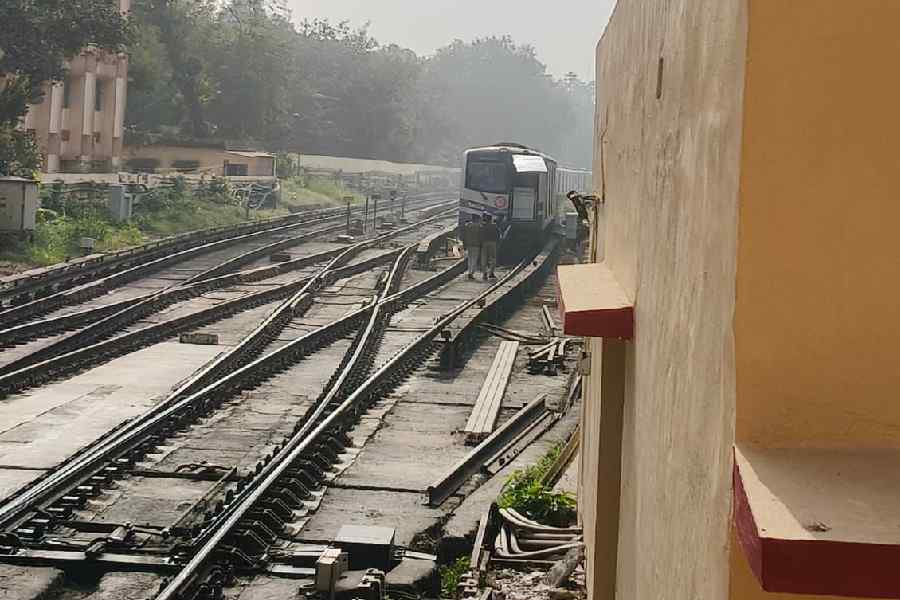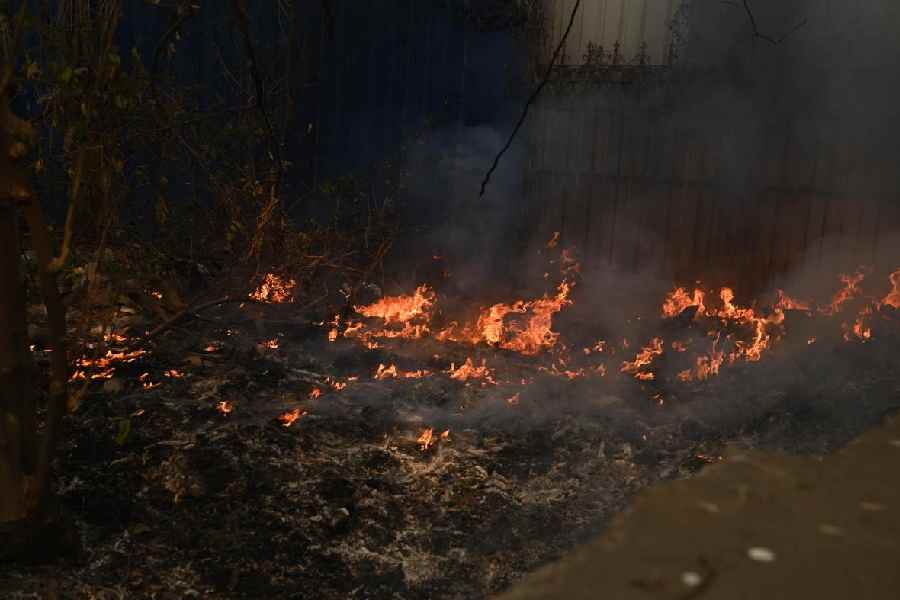 |
Hooghly, April 30: She still breaks out in a cold sweat every time she recalls that evening back in 1970 when she clung on to her six-month old baby as splinters from bombs exploding outside entered through the slits high up in the wall of her father’s modest Calcutta home.
Her father was a CPM sympathiser, a man of intense ideological conviction who never held a proper job, and was caught up like thousands of others in the street battles that raged between the CPM and whom they termed “Congshals” (a Naxalite-Congress combine during Siddharta Shankar Ray’s reign).
Her father is long dead, and Madhumita Sanyal (name changed) now lives in a small town near Champdani in Hooghly district. She worked as a schoolteacher all her life and her husband worked in a bank. Together, they managed to build a large house with a lovely garden and their home has all the trappings of the well-to-do middle class that today populates much of mofussil Bengal.
Although her son works in a private firm and her grandchildren study in an English medium school, Madhumita remains absolutely committed to “the Party”, and so is her entire extended family. Only the grandsons are too young yet, and get roundly ticked off for asking their “thakuma” what “maa maati maanush” means, words they have picked up after listening to Mamata’s anthem played endlessly on the school bus that ferries them to Chandernagore and back daily.
Madhumita and her husband, both retired, watch television a lot but despite Tata Sky’s plethora on offer, only 24 Ghonta is on these days. On the coffee table in the drawing room, lies a much-thumbed copy of Ganashakti — the only newspaper they care to read.
Every evening, they attend some “micchil” or “janasabha”, and in between talk to relatives and former colleagues in other small towns dotting Hooghly — Baidyabati, Chinsurah, Jangipara, Tarakeswar — to get the latest update. They reassure one another that this so-called “poribortoner hawa” is a figment of the “bourgeois” media’s imagination, that Gautam Deb’s speeches are having a “huge impact”, that the “silent vote” in the third phase has gone in their favour, that a “turnaround” is taking place even as we speak….
These daily, almost hourly doses of confidence-building measures fail to soothe Madhumita’s jagged nerves because her faith in the unfailing wisdom of the party’s “netas” was badly shaken in 2009. At that time, even hours before the result, the senior-most CPM leaders of the district, such as Rupchand Pal, had confidently asserted that the Left Front would lose a couple of seats here and there, but their tally would not fall below 30. In the event, they came down to an unimaginable 15 seats — losing two of the three Lok Sabha seats (Hooghly and Serampore) in the district and holding on to Arambagh by a significantly reduced margin.
Her husband and siblings, echoing the party line, keep telling her that things have changed since then. It was Prakash Karat’s “third front” fiasco and the expulsion of Somnath Chatterjee that caused the 2009 debacle — all other reasons were secondary, they say, as though Singur and Nandigram never happened, as though anti-incumbency were impossible against a government that “has done so much for the people”.
But Madhumita, sensitive to the change in the air that has invaded even the hermetically sealed homes of “party families”, cannot keep the panic out of her voice at the thought of the Left Front’s defeat. You don’t understand, she tells us, for people like her, “Party amaader pran, aamra Party ke khub bhalo bashi” (the Party is our life, we love the Party), the P always capped even in speech.
Madhumita, believe it or not, is not a member of the CPM. Her allegiance to the party comes from ties of blood and memory, ties that strengthened and flowered over the last many decades because of the profession she chose — teaching.
Madhumita, we discover, is not alone. The CPM may think of itself as the champion of the working class and peasantry but the party’s vanguard — in small towns and semi-rural areas across the state — is formed by teachers. School and college teachers, banded together under mass organisations such as All Bengal Primary School Teachers Association (ABPTA), All Bengal Teachers Association (ABTA) and West Bengal College and University Teachers Association (WBCUTA), are now at the forefront of the great “fightback” against the spectre of defeat that is haunting the CPM.
They are doing so for reasons both ideological and material. A majority of schoolteachers appointed in the early years of Left Front rule were drawn from families of CPM whole-timers or sympathisers. They belonged to the educated lower-middle class that formed the backbone of the Left — men and women who knew their Marx and Tagore, were sympathetic to ideas of equality and justice, spoke out on behalf of the ‘proletariat’ but were incapable of either tilling the land or working in a factory.
So pen and paper — or chalk and blackboard, to be precise — became their hammer and sickle and they found new status and stability under a dispensation that called for no struggle or sacrifice once the CPM became entrenched as a ruling party.
Teachers, whether in government or “grant-in-aid” schools, prospered as few have — with massive upward pay revisions, job security, provident fund, pensions and what have you. Most of them remain loyal to the Left, but over the past couple of years, the Opposition has made a breach in the teachers’ fort too.
The Trinamul Congress’s fledgling Schoolteachers Association (STA) has begun to grow, and in a sign of things to come, 18 teachers at a high school near Singur quit the ABTA at one go to join the STA a few months ago.
Madhumita may not admit it even to herself but one reason for her great anxiety is the fear that a new government will break the stranglehold of the Left in thousands of schools and colleges in the state, and bring in their own “riffraff” in place of the Left’s “master moshai” and “didimoni” who have for so long ruled the roost.
Party leaders here are banking on this “fear factor” among the beneficiaries of Left Front rule to push back the tide against them. The Left Front’s young minister, Soumendranath (Anjan) Bera, who is striving hard to retain his Pursurah seat in the once unassailable Red belt in the Arambagh division of Hooghly district, says: “This is not an electoral battle, this is a very fundamental battle that is going on — poriborton here means going back to the pre-1977 days. Our base of poor peasants realises that if the TMC wins, they will lose all the land and respect they gained after Operation Barga; their wages will decline, the old zamindars will return.”
In the same breath, he mentions schoolteachers: “For them, it is a do-or-die battle, they stand to lose everything they have gained in the past 34 years.”
In our journey across rural Hooghly — a fertile belt that grows rice and jute, potatoes and oilseeds — and its numerous little towns, we do find stray signs of this battle but not enough warriors on the Left’s side of it.
 |
| Foot soldiers: A teachers’ march in Calcutta. File picture |
In Harinkhala village which forms a part of the Pursurah seat, Subhas Santra — who admits to being a CPM cadre — tells us: “The poor are with the CPM because it is their party.” But the group of men and women who gather around, all of whom are fairly impoverished, maintain a sullen silence. Once he leaves, one person turns to us to say: “Every single person wants change this time. If we are allowed to vote, we will vote for change.”
A similar scene unfolds in Balabandh village under the Haripal seat, near Singur. Jayanta Bhuiyan says after Trinamul won just two of the 11 booths in the Koikola panchayat, they tried to grab land from tillers who had got the title after Operation Barga.
“The Party has managed to retrieve it but all the poor peasants now know the true face of Trinamul and are now coming back to us,” he says.
But when we step off the road and randomly talk to “khet mazdoors” bent over their jute crop under the scorching mid-day sun, Gopal Kamle — pointing to his disabled brother Mohanlal Kamle — complains: “The government has set aside money for disabled people but the anchal pradhan eats it up. This time, everyone plans to vote for change. Let us try them out once….”
Barring CPM’s rural cadres and the mofussil middle class which has directly gained from their allegiance to the party, the mass of ordinary people — at chai shops and at bus stands, tilling the field or hawking their wares — chant “poriborton” like a mantra, making the Left’s hope of winning at least eight of the 18 seats in Hooghly seem quite unlikely.
But it is also true that the despondency that overtook Left supporters after 2009 has been replaced by a new energy and assertion, laced with promises to make amends for past mistakes and apologies for misdeeds done. Not that it is making much difference.
Goutam Ghosh, a shopkeeper in Serampore, scoffs at Buddhadeb Bhattacharjee’s attempts to play good cop to Anil Basu’s bad. “Anil Basu has only repeated what Buddhadeb has been saying all along. The chief minister has always said he cannot make himself take the name of ‘oi mahila’ (that woman) — as though she were some despicable creature or associated with some unmentionable profession.
“As chief minister, he did not show her elementary courtesy. Anil Basu has only been a little more crude and direct,” Ghosh says, dismissing notions that the CPM was capable of correcting itself after the reverses it faced.
In a place called Kabley near Arambagh, Shyam Sundar Bose says Anil Basu’s comment has made the CPM’s position even shakier in an area that was under their iron grip. Asked if he had been a CPM voter in a seat where Anil Basu won with a record six lakh margin in 2004, he answers without a trace of irony: “We didn’t have to vote for the CPM, the CPM voted for us.”
But this time things have changed, he says, even in the four seats of Arambagh division (Arambagh, Pursurah, Khanakul, Goghat) the CPM could lose. Given the profusion of red flags and the fiery slogans that reverberate in the air, the CPM appears to be very strong here, we tell him.
“No,” he says, “we can tell the difference. If a cat gets caught in a corner, it swells up in rage and fear and starts snarling. It looks dangerous but it is only a pussycat.” Anil Basu’s comments reflect the CPM’s desperation just like the viciousness of a cornered cat, he says. So different from the quiet ferocity of the tiger it once was — here and everywhere.










